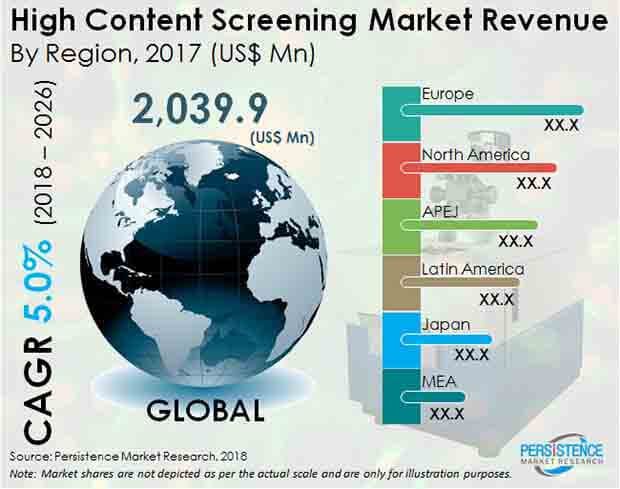High Content Screening Market Segmented By Cell Imaging and Analysis, consumables, Software, Services in Primary and Secondary Screening, Target Identification and Validation, Toxicity Studies, Compound Profiling.
Industry: Healthcare
Published Date: September-2018
Format: PPT*, PDF, EXCEL
Delivery Timelines: Contact Sales
Number of Pages: 265
Report ID: PMRREP12931
High content screening is an image based screening technique, which measures the physical and biochemical characteristics in the cells and the organisms. The high content screening includes the software for image capturing, its evaluation and data storage. High Content Screening (HCS), which is significantly transforming global businesses and enterprises.
New product launches is resulting in product assortment and thus, increased installation of High Content Screening (HCS) instruments. This is expected to bolster growth of the High Content Screening (HCS) market over. Owing to enhanced toxicity studies, demand for novel technologies in cell analysis is increasing rapidly across the globe. Instruments with enhanced cell imaging and analysis are preferred for early as well as later stages of the drug discovery process.
This is expected to fuel the demand for High Content Screening (HCS) instruments in the near future. Also, increasing government support for life sciences research and increasing progress towards establishment of innovation and research-based biotechnology industries, primarily in countries such as China and India, is expected to contribute towards increased growth rate during the forecast period.
The global high content screening market was valued at US$ 1,321.9 Mn in 2017 and is expected to expand at a CAGR of 5.0% over the forecast period (2018–2026).
The growth of the global high content screening market is mainly driven by Extensive Research and Development in innovation and drug discovery Increasing neurodegenerative diseases such as cancer, Alzheimer and Parkinson’s across the globe is expected to drive demand for advances healthcare services. This has led international players across the globe to invest considerably on research and development in order to introduce innovative products to cater to the demand across the supply chain in the near future.
Companies are developing automated solutions such as instruments with advanced visualization capability in line with enhanced software platform to sustain in a market that is being influenced by changing demographics on a global scale.
Owing to few efficient HCS systems manufacturers in this market, companies are focusing on cost optimization in order to increase productivity. Although, prices of High Content Screening (HCS) instruments are higher as compared to flow cytometers, availability of these instruments across educational institutions is expected to increase during the forecast period.
In order to offer comprehensive offerings to lab services, manufactures need to develop such instruments. Also, there has been an increase in development of automated systems to analyze cell separation and scalability. Demand for efficient purification protocols for therapeutic cells is expected to fuel demand for high-end screening system in the upcoming years
The global high content screening market has been segmented on the basis of regions into North America, Latin America, Western Europe, Eastern Europe, and Asia Pacific excluding Japan (APEJ), Japan and Middle East & Africa (MEA). In terms of revenue, North America is projected to be the dominant regional market for high content screening throughout the forecast period as manufacturers in the region are developing products that have the potential to analyze the live cells, its imaging and further target identification and validation of the drugs.
Moreover the device helps in analyzing the mutations and the changes in the RNA and toxicity studies which will improve in efficiency and development of the drugs. APECJ, Japan and China are expected to witness significant growth during the forecast period as numerous research and development activities are been carried out by the manufactures to improve the cell analyzers and flow cytomeres in the high content screening market. The U.S. is expected to be the dominant market in North America due to a advancement in the technologies. The U.S., Germany, the U.K. and Australia contribute a major share in the global high content screening market.

Since, the market for High Content Screening (HCS) instruments is consolidated in nature, major players across the globe are focused on developing new product offerings across various products, which includes instruments, consumables, software and services for cell analysis. This ensures sustainability in the long run and restricts new entrants from entering the market.
The global High Content Screening (HCS) market competitive landscape includes Becton, Dickinson and Company (BD), Thermo Fisher Scientific Inc., GE Healthcare, Olympus Corporation, PerkinElmer Inc., Merck Millipore Corporation, Danaher Corporation (Molecular Devices), Yokogawa Electric Corporation and Sysmex Corporation
| Attribute | Details |
|---|---|
| Product types |
|
| Applications covered |
|
| Industry covered |
|
| Regions covered |
|
To know more about delivery timeline for this report Contact Sales
